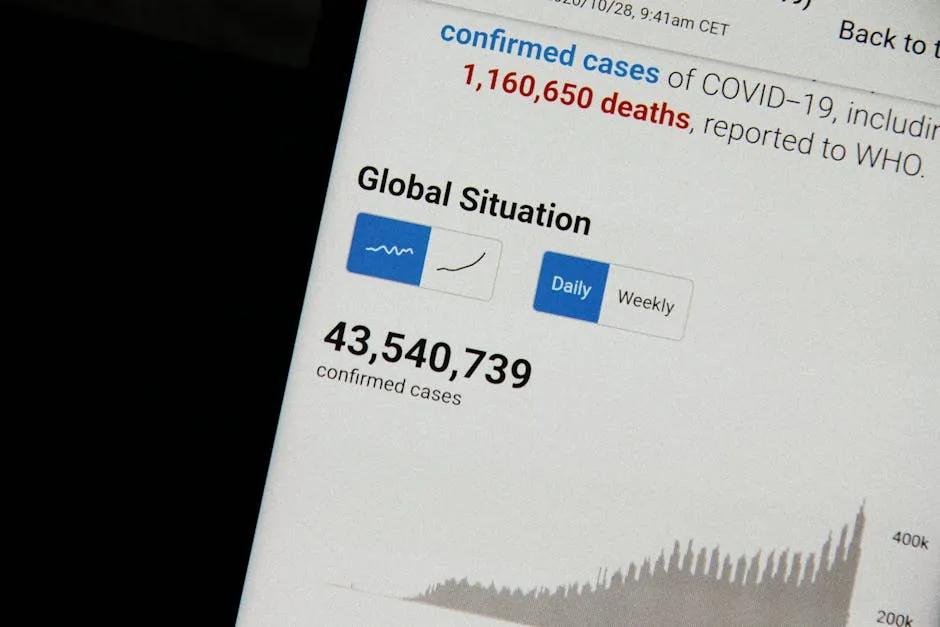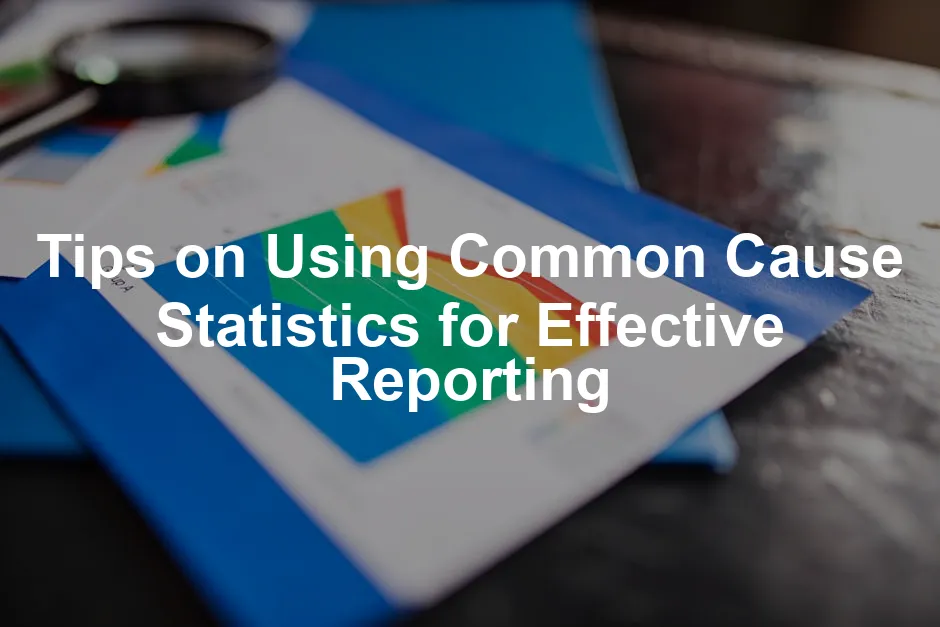Introduction
Statistics play a crucial role in reporting across various fields. Whether it’s journalism, business, or healthcare, these numbers help tell a story. However, not all statistics are created equal. Common cause statistics are particularly important as they reflect the usual variations in a system. Understanding and using these statistics effectively can significantly improve reporting accuracy.

The purpose of this article is to provide practical tips for effectively using common cause statistics in reporting. By adhering to these tips, reporters can avoid common pitfalls, enhance clarity, and ensure that their audience comprehends the data presented.
In today’s data-driven world, reliance on statistics is skyrocketing. Journalists are increasingly expected to interpret complex data sets. Businesses use statistics to drive decisions, while healthcare professionals rely on them for patient outcomes. As data becomes more central to our narratives, the need for accurate and effective reporting grows. This article aims to equip you with the tools necessary to navigate common cause statistics like a pro.
Understanding Common Cause Statistics
What Are Common Cause Statistics?
Common cause statistics represent the normal, expected variations in a system. Unlike special cause statistics, which indicate unusual variations due to specific events, common cause statistics reflect inherent fluctuations within a process. These statistics are crucial in understanding the baseline performance of a system.
For example, consider a manufacturing process. Variations in product dimensions due to machine calibration might be common cause statistics. These variations are expected and can be accounted for over time. On the other hand, a sudden spike in defects due to a machine failure would be an example of special cause statistics, indicating something out of the ordinary.
In public health, common cause statistics could include seasonal variations in flu cases. These fluctuations are part of the regular pattern of disease spread. Recognizing this helps health officials plan and allocate resources effectively. By understanding the nature of common cause statistics, reporters can better interpret data and provide a more accurate context for their audience.

Importance of Common Cause Statistics in Reporting
Reliability
Common cause statistics are the backbone of reliable reporting. They provide a foundation of expected variations within a system. When reporters understand these statistics, they can communicate data with confidence. This leads to trustworthiness in their reports.
Imagine a weather report forecasting a 20% chance of rain. That percentage is based on common cause statistics. It reflects historical weather patterns, helping people plan their day. Without such data, the forecast would be less reliable and more guesswork.
In various fields, such as healthcare and manufacturing, common cause statistics help establish baselines. They indicate what is “normal,” allowing for better decision-making. When deviations occur, they can be identified and addressed promptly. Thus, statistics enhance the overall quality of reporting.
If you’re looking to dive deeper into understanding statistics, consider checking out “The Art of Statistics: Learning from Data” by David Spiegelhalter. It provides fantastic insights into how statistics can shape our understanding of the world.
Trends and Patterns
Common cause statistics also play a vital role in identifying trends and patterns over time. By analyzing these statistics, reporters can spot fluctuations and shifts. This is crucial for understanding how different factors influence outcomes.
Consider public health data, where seasonal variations in flu cases are common. Understanding these patterns allows health officials to allocate resources effectively during peak seasons. When reporters highlight these trends, they provide valuable context for readers.
For businesses, common cause statistics reveal customer behavior trends. By analyzing purchasing patterns, companies can tailor their marketing strategies. This insight helps them stay competitive in a fast-paced market.

For a more engaging way to present your data, consider reading “Storytelling with Data” by Cole Nussbaumer Knaflic. It’s a great resource for anyone looking to enhance their data visualization skills.
In summary, common cause statistics are essential for reliable reporting. They enable the identification of trends and patterns, enhancing the quality of information presented. Reporters who leverage these statistics can illuminate their stories, leading to more informed audiences.

3. Communicate Effectively
When it comes to reporting statistics, clarity is your best friend. Using straightforward language is crucial. Avoid jargon and technical terms that might leave your audience scratching their heads. Instead, opt for simple words and phrases that everyone can grasp. Remember, the goal is to convey your findings, not to confuse your readers.
Think of it this way: You wouldn’t want to explain the rules of a game using a foreign language, would you? Similarly, when presenting statistics, make sure your language is accessible. This approach ensures that even those with minimal statistical knowledge can follow along and understand your points.
Next, consider your audience’s statistical literacy. Not everyone is a math whiz or a data analyst. Tailor your communication style based on who you’re addressing. For example, when speaking to industry experts, you can afford to use more technical language. But if your audience is the general public, keep it light, engaging, and easy to digest.
Using analogies can work wonders. Instead of saying a statistic has increased by 20%, relate it to something familiar. For instance, “That’s like adding two slices of pizza to a six-slice pie.” This helps your audience visualize the data and makes it more relatable.
Visual aids can also enhance comprehension. Charts, graphs, and infographics can simplify complex data. They provide a visual representation that can sometimes communicate a point more effectively than words alone. A well-placed pie chart can convey proportions at a glance, while a line graph can show trends over time. Don’t shy away from using these tools to support your narrative.

Lastly, remember that effective communication is a two-way street. Encourage questions and discussions. If someone is confused, it’s an opportunity to clarify your points and improve understanding. After all, a statistic is only as good as the story it helps to tell.
4. Report Limitations and Assumptions
Transparency is the name of the game when reporting statistics. It’s vital to disclose the limitations and assumptions underlying your data. This kind of honesty builds trust with your audience. It shows you’re not just throwing numbers at them but are willing to share the full picture.
For instance, if your data comes from a small sample size, let your readers know. A small sample might not accurately represent the larger population. This is a crucial caveat that can influence how your findings are interpreted.
Another common limitation is the potential for bias in data collection. If you’ve gathered data from a source that might have vested interests, mention it. Acknowledging these biases can help your audience critically evaluate the information you present.
Also, be clear about the assumptions that accompany your analysis. For example, if you assume a linear relationship between two variables, state it upfront. This assumption might not always hold true in real-world scenarios, and failing to mention it could mislead your audience.

Consider this: If you’re calculating averages, clarify whether you’re using mean, median, or mode. Each measure can tell a different story, so being specific helps keep your audience informed.
Finally, don’t forget to highlight any external factors that could impact your findings. For example, if your data reflects a trend over several years, but a major event occurred during that time, discuss how it might have influenced the results.
By being transparent about limitations and assumptions, you empower your audience to understand the context of your findings. This not only enhances the credibility of your report but also encourages informed discussions.
5. Use Statistical Tools and Software
In the digital age, leveraging statistical tools and software is essential for effective data analysis and reporting. A variety of applications are available to help streamline your data handling processes. Tools like Python for Data Analysis by Wes McKinney and R for Data Science by Hadley Wickham can analyze complex datasets and generate meaningful insights.

Don’t overlook visualization software like Tableau or Power BI. These platforms transform raw data into interactive dashboards and graphs, making it easier for your audience to grasp your findings. They help turn tedious numbers into compelling stories, enhancing engagement.
Beyond just using these tools, ongoing training is crucial. Encourage your team to participate in workshops or online courses. Familiarity with statistical methods and software can significantly improve the quality of your reporting. Knowledge is power, and in this case, it can lead to more accurate analysis and insightful conclusions.
Consider hosting regular training sessions. Whether it’s a lunch-and-learn or a full-day workshop, these opportunities foster a culture of continuous learning. They also ensure that everyone is on the same page regarding data handling and reporting standards.
Finally, remind your team to stay curious. Statistics is a field that evolves quickly. New methods and tools continuously emerge, so keeping abreast of advancements will only enhance your reporting capabilities.
By utilizing statistical tools effectively and investing in ongoing training, you can ensure your reporting remains accurate, insightful, and relevant. This approach not only benefits your organization but also builds trust with your audience through reliable data presentation.

Case Studies of Effective Reporting Using Common Cause Statistics
Case Study 1: Public Health Reporting
In the realm of public health, accurate data reporting is a life-saver—literally. One prominent example comes from the Centers for Disease Control and Prevention (CDC) during the flu season. They published a detailed report on flu activity by utilizing common cause statistics. This approach allowed them to track seasonal flu trends effectively, showcasing historical data patterns.
The CDC used data collected from healthcare providers, hospitals, and laboratories to identify peak flu seasons. By comparing current data with previous years, they were able to establish a baseline of expected flu cases. This context was crucial. When they found a spike in cases, it wasn’t just numbers; it was a call to action for public health officials.

The outcomes were striking. By utilizing these common cause statistics, the CDC could recommend targeted vaccination campaigns and allocate resources to areas experiencing higher-than-expected flu activity. As a result, vaccination rates increased, and resources were efficiently directed where they were most needed. The proactive approach led to a significant reduction in hospitalizations and flu-related deaths, demonstrating the power of using common cause statistics for effective health reporting.
Case Study 2: Business Performance Analysis
Businesses thrive on data, but interpreting that data correctly is essential for success. A compelling case study involves a leading retail chain that faced declining sales. The management team turned to common cause statistics to analyze sales performance across different store locations.
By examining transaction data over time, the team identified patterns in customer buying behavior. They utilized common cause statistics to determine fluctuations due to factors like seasonality and promotions. This analysis revealed that certain stores consistently underperformed due to location issues rather than poor management or staff performance.

Imagine having a comprehensive guide to business statistics at your fingertips. Check out “Statistics for Business and Economics” by Paul Newbold. It’s a great resource for anyone looking to enhance their understanding of business statistics.
In summary, common cause statistics are essential for reliable reporting. They enable the identification of trends and patterns, enhancing the quality of information presented. Reporters who leverage these statistics can illuminate their stories, leading to more informed audiences.

Conclusion
In summary, using common cause statistics effectively is essential for accurate reporting across various fields. Here’s a recap of the key tips and best practices discussed in this article.
First, understanding your data is paramount. Accurate data collection and analysis lay the groundwork for reliable reporting. Next, contextualizing the data helps avoid misinterpretation. Providing the necessary context ensures that your audience can grasp the significance of the statistics presented. For more insights on this, consider exploring inferential statistics vs descriptive statistics in data interpretation.
Understanding the differences between inferential and descriptive statistics can greatly enhance your data interpretation skills. Learn more about this topic here.
Communication is another critical aspect. Using clear language and visual aids enhances your audience’s understanding of complex data. Tailoring your communication style to your audience’s statistical literacy also plays a vital role in effective reporting.

Transparency about limitations and assumptions is crucial. By openly discussing these aspects, you build trust with your audience. It’s all about painting a complete picture of the data you present.
Utilizing statistical tools and software can streamline your analysis and reporting processes. Investing in training and ongoing education ensures that your team stays updated on best practices for statistical analysis. If you’re interested in diving deeper into statistical methods, consider “Practical Statistics for Data Scientists” by Peter Bruce. It’s a fantastic resource!
Finally, remember that common cause statistics are more than mere numbers. They are powerful tools for revealing trends, patterns, and insights that can drive decision-making. By following these tips, you can harness these statistics to enhance your reporting, whether in healthcare, business, or any other field.
FAQs
What is the difference between common cause and special cause statistics?
Common cause statistics represent the normal variations inherent in a process. They reflect predictable patterns that occur regularly. In contrast, special cause statistics indicate unusual variations resulting from specific, identifiable causes. Understanding this distinction is crucial for accurate data interpretation.
How can I ensure that my statistics are accurately reported?
To ensure accurate reporting, start by validating your data sources. Employ rigorous data collection methods and analyze the data with appropriate statistical techniques. Additionally, be transparent about limitations and communicate findings clearly to your audience.
What tools can I use for statistical analysis and reporting?
There are numerous tools available for statistical analysis, including R, Python, and SPSS. For reporting, consider using visualization software like Tableau or Power BI. These tools can help present your data in an engaging and understandable manner.
Why is context important when reporting statistics?
Context is vital because it helps your audience understand the relevance and implications of the data. Without context, statistics can be easily misinterpreted. Providing background information ensures that your findings are accurately conveyed and understood.
Please let us know what you think about our content by leaving a comment down below!
Thank you for reading till here 🙂
All images from Pexels




